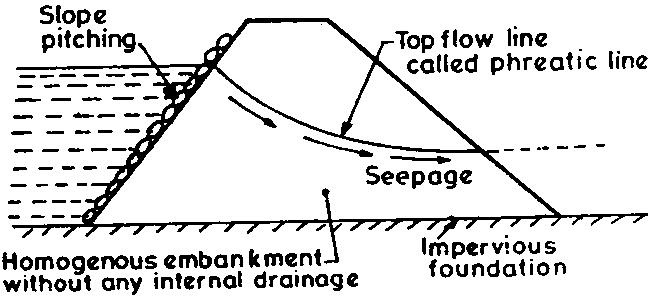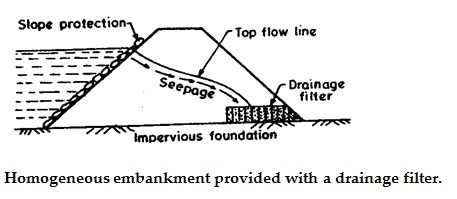Chapter: Civil : Water Resources and Irrigation Engineering : Diversion and Impounding Structures
Earthen Dams and Rock Fill Dams
Earthen Dams and Rock Fill Dams
Introduction
Earthen
dams and earthen levees are the most ancient type of embankments, as they can
be built with the natural materials with a minimum of processing and primitive
equipment. But in ancient days, the cost of carriage and dumping of the dam
materials was quite high. However, the modern developments in earth moving equipments
have considerably reduced the cost of carriage and laying of the dam materials.
The cost of gravity dams on the other hand, has gone up because of an increase
in the cost of concrete, mesonry, etc. Earthen dams are still cheaper as they
can utilize the locally available materials, and less skilled labour is
required for them.
Gravity
dams and arch dams require sound rock foundations, but earthen dams can be
easily constructed on earth foundations. However, earth dams are more
susceptible to failure as compare to rigid gravity dams or arch dams. Before
the development of the subject of Soil-Mechanics, these dams were being
designed and constructed on the basis of experience, as no rational basis for
their design was available. This led to the failure of various such earthen
embankments. However, in these days, these dams can be designed with a fair
degree of theoretical accuracy, provided the properties of the soil placed in
the dam, are properly controlled. This condition makes the design and construction
of such dams, thoroughly interdependent. Continuous field observations of
deformations and pore water pressures have to be made during the construction
of such dams. Suitable modifications in the design, are then made during
construction, depending upon these field observations.
Type of Earthen Dams
The earthen dam can be of the following three types:
1.
Homogeneous
Embankment type
2.
Zone
embankment type
3.
Diaphragm
type.
These three types of dams are described below:

Figure:
(a) Homogenous type embankment


Figure: Zoned type embankment
The
central core checks the seepage. The transition zone prevents piping through
cracks which may develop in the core. The outer zone gives stability to the
central impervious fill and also distribute the load over a large area of
foundations.
This type
of embankment are widely constructed and the materials of the zones are
selected depending upon their availabilities. Caly, inspite of it being highly
impervious, may not make the best core, if it shrinks and swells too much. Due
to this reason, clay is sometimes mixed with fine sand or fine gavel, so as to
use it as the most suitable material for the central impervious core. Silts or
silty clays may be used as the satisfactory central core materials. Freely
draining materials, such as coarse sands and gravels, are used in the outer
shell. Transition filters are provided between the inner zone and the outer
zone, as shown in fig. This type of transition filters are always provided,
whenever there is an abrupt change of permeability from one zone to the other.
(3) Diaphragm Type Embankments. Diaphragm type embankments have a thin
impervious core, which is surrounded by earth or rock fill. The
impervious core, called diaphragm, is made of impervious soils, concrete,
steel, timber or any other material. It acts as a water barrier to prevent seepage
through the dam. The diaphragm may be placed either at the centre as a central
vertical core or at the upstream face as a blanket. The diaphragm must also be
tied to the bed rock or to a very impervious foundation material, if excessive
under-seepage through the existing previous foundations has to be avoided
(fig.).

Figure: Diaphragm type embankment
The
diaphragm type of embankments are differentiated from zoned embankments,
depending upon the thickness of the core. If the thickness of the diaphragm at
any elevation is less than 10 elevation is less than the height of the
embankment above the corresponding
elevation, the dam embankment is
considered to b equals or exceeds or exceeds these limits, it is considered to
be of zoned embankment type.
Methods of Construction
There are two methods of constructing earthen dams:
(1) Hydraulic-fill Method; and
(2) Rolled-fill Method.
(1) Hydraulic-fill Method. In this method of construction, the
dam body is constructed by excavating and transporting soils by using
water. Pipes called flumes, are laid along the outer edge of the embankment.
The soil materials are mixed with water and pumped into these flumes. The slush
is discharged through the outlets in the flumes at suitable intervals along
their lengths.
The slush, flowing towards the centre
of the bank, tends to settle down. The coarser particles get deposited soon
after the discharge near the outer edge, while the fines get carried and settle
at the centre, forming a zoned embankment having a relatively impervious
central core.
Since the
fill is saturated when placed, high pore pressures develop in the core
material, and the stability of the dam must be checked for these pressures.
This type of embankment is susceptible to settlement over long periods, because
of slow drainage from the core.
Hydraulic-fill
method is, therefore, seldom adopted these days. Rolled-fill method for
constructing earthen dams is, therefore, generally and universally adopted in
these modern days.
(2) Rolled-fill Method. The embankment is constructed by
placing suitable soil materials in thin layers (15 to 30 cm) and
compacting them with rollers. The soil is brought to the site from burrow pits
and spread by bulldozers, ect. In layers. These layers are thoroughly compacted
by rollers of designed weights. Ordinary road rollers can be used fro low
embankments (such as for levees or bunds); while power-operated rollers are to
be used for dams. The moisture content of the soil fill must be properly
controlled. The best compaction can be obtained at a moisture content somewhere
near the optimum moisture content. (The optimum moisture content is the
moisture required for obtaining optimum density in the fill). Compaction of
coarse gravels cannot be properly done by rolling and is best done by vibrating
equipment. Detail of rolling and
compacting different types of soils
are available i by the same author.
Shearing Strength of Soils
Before we
describe the causes of failure of earthen dams and the criteria for their safe
design; we shall review a few important conceptions of soil-mechanics and their
importance in the design of earth dams.
Classification
Irrigation projects, are classified
into two Main categories. They are
1.
Diversion
works
2.
Storage
works
Diversion Works
The
purpose of a diversion work is mainly to raise the water level and divert the
river flows into canals to feed the ayacut. A diversion work consists of an
anicut or a weir across the stream or river, by which the water level could be
raised to divert it into canals on either side of the river or stream.
There is no question of any storage
here.
The main component works in this case
are:
1.
A
weir or Anicut across the river or stream in question
2.
Head
sluices or Head Regulators at either end to feed the canals on either side.
3.
Scour
sluices on either side to prevent silting of the approaches to the Heal
Regulator.
A detailed
design of a
River weir is
given i
Storage Works
In big
irrigation projects, where the river, the main source of water, has enough
flows in the year and which go waste un-utilized, storage works are resorted
to, to conserve the water by creating a reservoir, conserve the flows as far as
possible without detriment to the riparian rights of the areas below the
reservoir on the same river. These projects involving construction of huge
reservoirs are also designed to serve as multipurpose projects. A multipurpose
project means that it should serve the following useful purposes:
1.
Flood
control
2.
Irrigation.
3.
Power
generation.
4.
Navigation.
5.
Improve
fish culture, and
6.
Supply
of drinking water.
A storage work, consists of the following components
1.
A
dam across the river to create a reservoir of adequate capacity to irrigate the
command area, with provision for letting down the surplus water down stream.
2.
Head
Regulators on either side to feed the main canals.
3.
Main
canals and distributory system to feed the commanded area.
Related Topics